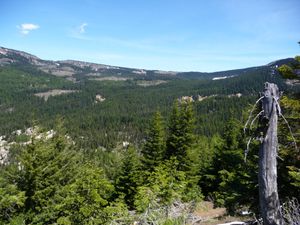Four-year effort protects 10,000 acres in Cascades for wildlife
WILDLIFE CONSERVATION -- Good things don't always come quick and easy.
Hunters and other conservationists are reminded of that this week as a deal closed to seal four years of negotiations by a partnership of conservation groups and state agencies. The project blocks up and protects about 10,000 acres of public land for big-game and other wildlife in the east and central Cascades.
The deal has foresight to secure the real estate elk and other critters need from winter to summer range.
The Washington Fish and Wildlife Commission approved the most recent purchase in November, using funding from the Washington Wildlife and Recreation Grant Program.
But the negotiations and original purchases of land were undertaken by the Rocky Mountain Elk Foundation and The Nature Conservancy. The land was purchased from Plum Creek Timber Company to prevent the land from being developed or subdivided as well as to maintain public access.
The first phase of the project was completed in 2009, securing 2,675-acres.
Read on for details from a just-issued RMEF media release a day after the final phase of the deal was closed.
10,000 Acres Protected in the Heart of the Cascades
Transfer of land to state completes four-year conservation project
ELLENSBURG, Wash.--In the Cascade Mountains some 20 miles east of Ellensburg, a coalition of conservation partners has completed a four-year project to secure wildlife habitat and public access on 10,386 acres of forests by transferring it from Plum Creek to the state Department of Fish and Wildlife.
The coalition was led by the Rocky Mountain Elk Foundation (RMEF), The Nature Conservancy and the Washington Department of Fish and Wildlife (WDFW).
The Heart of the Cascades (aka Rock Creek/Bald Mountain) project was completed in phases.
The final phase, which closed Dec. 15, involved 7,711 acres of Plum Creek lands situated in a "checkerboard" pattern within the Wenatchee National Forest. RMEF worked with Plum Creek to transfer 3,904 acres, while the Conservancy transferred another 3,807 acres, to WDFW.
In 2009, during the project's first phase, the Conservancy and RMEF worked together to acquire and transfer 2,675 acres to WDFW.
All of the lands are now part of WDFW's 47,200-acre Oak Creek Wildlife Management Area. The land is also part of a larger landscape, the Tapash Sustainable Forest Collaborative, where WDFW, the Forest Service, the Conservancy, RMEF, the state Department of Natural Resources, the Yakama Nation and other public land managers are working together to restore forest health.
"This was a very complex project--I don't think any of the partners could have accomplished this alone," said David Allen, RMEF president and CEO. "Together, we helped 'block up' public land in larger contiguous holdings and protect habitat for elk and other big game, from low elevation winter ranges all the way up to high-country summer ranges. And what's good for big game is also good for big-game hunters."
"By bringing this area into public ownership, we'll be able to work together to maintain a healthy forest environment, to lower the danger of catastrophic wildfire and ensure that people can continue to hike and camp and hunt here, supporting the local economy" said Karen Anderson, Washington director for The Nature Conservancy.
WDFW funding came from the Washington Wildlife and Recreation Program and the U.S. Fish and Wildlife Service via a Habitat Conservation Plan grant.
"This project was a high priority for the state because it provides critical habitat both for protected species and game animals," said Jeff Tayer, WDFW's regional director in Yakima. "This diverse habitat supports threatened and endangered species such as spotted owls, bull trout and steelhead, as well as big-game such as elk, bighorn sheep and mountain goats."
"Plum Creek commends the efforts to conserve the land and retain important habitat in this region. We are pleased that our company could help advance this partnership," said Rick Holley, president and chief executive officer, Plum Creek.
In addition to the partners, a broad coalition including Kittitas County commissioners supported the project.
The Rock Creek/Bald Mountain area hosts a wide variety of wildlife with over 100 species of birds, including several rare species. Ranging from 2,500 to 6,000 feet in elevation, it includes alpine areas home to elk and blue grouse, shrub-steppe habitat and basalt cliffs for golden eagles, peregrine falcon, mule deer and bighorn sheep, and streams used by amphibians, steelhead, bull trout, and Chinook and coho salmon.
Piecemeal purchases by small timber operations or rural residential developers could have compromised wildlife values as well as public access. From the outset, Plum Creek felt the lands were best suited as wildlife and recreation lands, and allowed the coalition of project partners time to assemble the needed funding to complete a deal.

